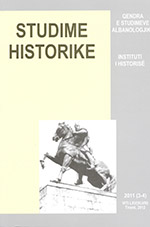Përkime Shqiptaro-Malazeze Në Mesjetë
Albanian-Montenegrin Commonalities During The Middle Ages
Author(s): Pëllumb XhufiSubject(s): History
Published by: Qendra e Studimeve Albanologjike
Keywords: Middle-Age; Albanian-Montenegrin ; Albania; Albanian History;
Summary/Abstract: For a long time, there has been a lively debate about the identity, the culture, and the political and legal institutions of Montenegro (Dioclea, Zeta) in the Middle Ages. One theory, mainly supported by Serbian scholars, argues that Montenegro as well as the regions north and north-east of it, became ethnically Slav during the colonization of the sixth and seventh centuries and therefore, the history of this country and its people is a part of the Serbians' history. Other scholars, on the contrary, are firm in their argument that Montenegro during the Slavic settling, was not affected, at least not to a large extent and that this territory was ethnically, politically and culturally linked with the regions southwards, belonging to present day Albania. In fact, the Byzantine historian of the tenth century, Constantine Porphyrogenetus clearly states that in the south the Slavic colonization spread up to the bay of Kotor (Deukaterion), where the Byzantine Emperor Herakles allowed to settle people of the tribes of Zakluma, Tërbuna and Kanalit, Slavic tribes distinguished from Serbian ones that were settled in the interior of the country. The archeological discoveries and anthropological researches also show the historical continuity in the region of Dioclea. In addition, the Serbian chronicles starting from the thirteenth century onwards consider Dioclea and its population as foreign. One element that strongly testifies this is undoubtedly the acceptance of Catholicism in contrast to what happened in Serbia.
Journal: Studime Historike
- Issue Year: 2011
- Issue No: 03-04
- Page Range: 031-054
- Page Count: 24
- Language: Albanian
- Content File-PDF

